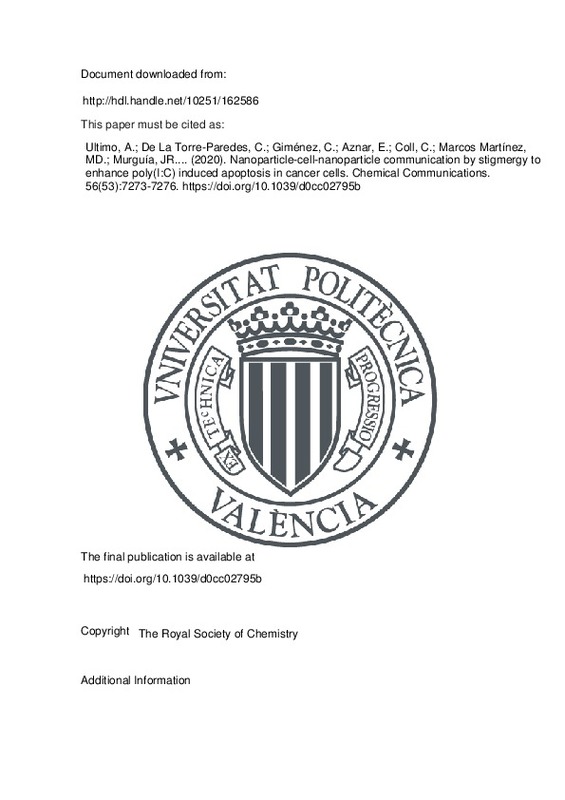Schaming, D., & Remita, H. (2015). Nanotechnology: from the ancient time to nowadays. Foundations of Chemistry, 17(3), 187-205. doi:10.1007/s10698-015-9235-y
Hauert, S., & Bhatia, S. N. (2014). Mechanisms of cooperation in cancer nanomedicine: towards systems nanotechnology. Trends in Biotechnology, 32(9), 448-455. doi:10.1016/j.tibtech.2014.06.010
Theraulaz, G., & Bonabeau, E. (1999). A Brief History of Stigmergy. Artificial Life, 5(2), 97-116. doi:10.1162/106454699568700
[+]
Schaming, D., & Remita, H. (2015). Nanotechnology: from the ancient time to nowadays. Foundations of Chemistry, 17(3), 187-205. doi:10.1007/s10698-015-9235-y
Hauert, S., & Bhatia, S. N. (2014). Mechanisms of cooperation in cancer nanomedicine: towards systems nanotechnology. Trends in Biotechnology, 32(9), 448-455. doi:10.1016/j.tibtech.2014.06.010
Theraulaz, G., & Bonabeau, E. (1999). A Brief History of Stigmergy. Artificial Life, 5(2), 97-116. doi:10.1162/106454699568700
Llopis-Lorente, A., Díez, P., Sánchez, A., Marcos, M. D., Sancenón, F., Martínez-Ruiz, P., … Martínez-Máñez, R. (2017). Interactive models of communication at the nanoscale using nanoparticles that talk to one another. Nature Communications, 8(1). doi:10.1038/ncomms15511
Luis, B., Llopis‐Lorente, A., Rincón, P., Gadea, J., Sancenón, F., Aznar, E., … Martínez‐Máñez, R. (2019). An Interactive Model of Communication between Abiotic Nanodevices and Microorganisms. Angewandte Chemie International Edition, 58(42), 14986-14990. doi:10.1002/anie.201908867
De la Torre, C., Domínguez-Berrocal, L., Murguía, J. R., Marcos, M. D., Martínez-Máñez, R., Bravo, J., & Sancenón, F. (2018). ϵ
-Polylysine-Capped Mesoporous Silica Nanoparticles as Carrier of the C
9h
Peptide to Induce Apoptosis in Cancer Cells. Chemistry - A European Journal, 24(8), 1890-1897. doi:10.1002/chem.201704161
García-Fernández, A., García-Laínez, G., Ferrándiz, M. L., Aznar, E., Sancenón, F., Alcaraz, M. J., … Orzáez, M. (2017). Targeting inflammasome by the inhibition of caspase-1 activity using capped mesoporous silica nanoparticles. Journal of Controlled Release, 248, 60-70. doi:10.1016/j.jconrel.2017.01.002
Murugan, C., Rayappan, K., Thangam, R., Bhanumathi, R., Shanthi, K., Vivek, R., … Kannan, S. (2016). Combinatorial nanocarrier based drug delivery approach for amalgamation of anti-tumor agents in breast cancer cells: an improved nanomedicine strategy. Scientific Reports, 6(1). doi:10.1038/srep34053
Van Rijt, S. H., Bölükbas, D. A., Argyo, C., Datz, S., Lindner, M., Eickelberg, O., … Meiners, S. (2015). Protease-Mediated Release of Chemotherapeutics from Mesoporous Silica Nanoparticles to ex Vivo Human and Mouse Lung Tumors. ACS Nano, 9(3), 2377-2389. doi:10.1021/nn5070343
Llopis-Lorente, A., Lozano-Torres, B., Bernardos, A., Martínez-Máñez, R., & Sancenón, F. (2017). Mesoporous silica materials for controlled delivery based on enzymes. Journal of Materials Chemistry B, 5(17), 3069-3083. doi:10.1039/c7tb00348j
Bianchi, F., Pretto, S., Tagliabue, E., Balsari, A., & Sfondrini, L. (2017). Exploiting poly(I:C) to induce cancer cell apoptosis. Cancer Biology & Therapy, 18(10), 747-756. doi:10.1080/15384047.2017.1373220
Ultimo, A., Giménez, C., Bartovsky, P., Aznar, E., Sancenón, F., Marcos, M. D., … Murguía, J. R. (2016). Targeting Innate Immunity with dsRNA-Conjugated Mesoporous Silica Nanoparticles Promotes Antitumor Effects on Breast Cancer Cells. Chemistry - A European Journal, 22(5), 1582-1586. doi:10.1002/chem.201504629
Bernardo, A. R., Cosgaya, J. M., Aranda, A., & Jiménez-Lara, A. M. (2013). Synergy between RA and TLR3 promotes type I IFN-dependent apoptosis through upregulation of TRAIL pathway in breast cancer cells. Cell Death & Disease, 4(1), e479-e479. doi:10.1038/cddis.2013.5
Clarke, N., Jimenez-Lara, A. M., Voltz, E., & Gronemeyer, H. (2004). Tumor suppressor IRF-1 mediates retinoid and interferon anticancer signaling to death ligand TRAIL. The EMBO Journal, 23(15), 3051-3060. doi:10.1038/sj.emboj.7600302
Kajita, A. i., Morizane, S., Takiguchi, T., Yamamoto, T., Yamada, M., & Iwatsuki, K. (2015). Interferon-Gamma Enhances TLR3 Expression and Anti-Viral Activity in Keratinocytes. Journal of Investigative Dermatology, 135(8), 2005-2011. doi:10.1038/jid.2015.125
Weihua, X., Kolla, V., & Kalvakolanu, D. V. (1997). Modulation of Interferon Action by Retinoids. Journal of Biological Chemistry, 272(15), 9742-9748. doi:10.1074/jbc.272.15.9742
[-]







![[Cerrado]](/themes/UPV/images/candado.png)


